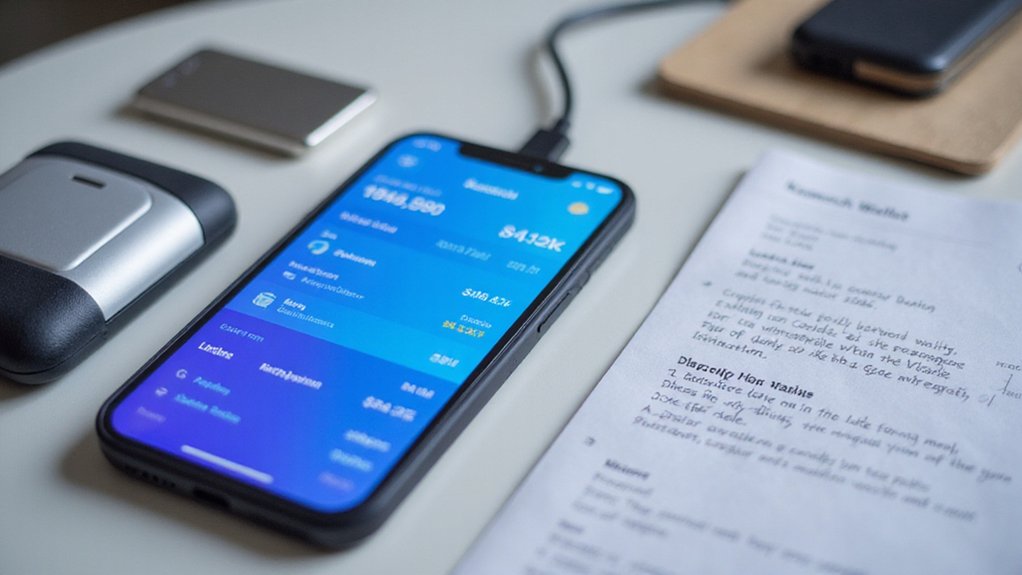KAANCH staking offers an impressive 119% APY for early participants, with rewards accruing in real-time during the presale phase. Investors earn passive income through a Delegated Proof of Stake mechanism while simultaneously bolstering network security. Currently priced at $0.16 in Stage 5 of its presale, KAANCH’s Layer 1 blockchain boasts 1.4 million TPS and sub-$0.0001 transaction costs. The protocol’s interoperability with major chains suggests potential beyond mere speculative returns.

While the crypto landscape continues to evolve with increasingly ambitious promises of returns, Kaanch Network has emerged as a particularly remarkable contender in the passive income arena—offering staking rewards that would make traditional financial instruments blush with inadequacy.
The platform’s staking mechanism boasts an eye-watering 119% APY for early participants—a figure that, were it offered in conventional finance, would trigger regulatory investigations with breathtaking swiftness.
This Layer 1 blockchain distinguishes itself through impressive technical specifications: 1.4 million transactions per second with 0.8-second finality (numbers that, if substantiated post-launch, would position Kaanch among the highest-performing networks in existence).
The infrastructure relies on Delegated Proof of Stake, allowing token holders to participate in network security while receiving passive income for their contribution. The network delivers real-time staking rewards to users, eliminating waiting periods typically associated with other blockchain platforms.
Currently in Stage 5 of its presale with tokens priced at $0.16, Kaanch presents an enticing proposition—immediate earnings that begin accruing during the presale phase itself, rather than requiring investors to wait until full network deployment.
This approach cleverly incentivizes early adoption while simultaneously reducing circulating supply through lock-up mechanisms.
The network’s architecture supports real-world asset tokenization and interoperability with established blockchains like Ethereum, Solana, and BNB, potentially positioning it for institutional adoption—assuming it can navigate the increasingly complex regulatory environment surrounding digital assets.
The project has already demonstrated significant market interest by raising over 1.12 million dollars in its presale phases.
Transaction costs remain minuscule at less than $0.0001, ostensibly enabling microtransactions that remain economically unfeasible on legacy networks.
The $KNCH token provides practical ecosystem participation while delivering real utility beyond mere speculative value.
Naturally, prudent investors will recognize the inherent speculative nature of such ventures.
Despite impressive technical claims and attractive reward structures, Kaanch faces formidable competition from established players with substantial developer ecosystems.
The project’s success ultimately hinges on market adoption and regulatory compliance—factors that have proven fickle even for projects with impeccable technical credentials.
Nevertheless, for investors with appropriate risk tolerance, Kaanch’s staking program represents an opportunity to participate in what could potentially be a significant advancement in blockchain technology.
Frequently Asked Questions
What Are the Risks Associated With KAANCH Staking?
Kaanch staking presents a multilayered risk profile typical of nascent blockchain ventures.
Investors face technical vulnerabilities in an unproven protocol, potentially unsustainable APYs (a remarkable 119% during presale—one might raise an eyebrow), illiquidity during unstaking periods, and possible slashing penalties.
Market volatility compounds these concerns, while regulatory uncertainties loom large.
The network’s ambitious AI integrations and dependencies on external partnerships (including, curiously, Trump’s crypto ventures) further complicate the risk assessment calculus for potential stakers.
Is There a Minimum Staking Period for KAANCH Tokens?
Based on available information, no explicit minimum staking period appears to exist for KAANCH tokens.
The staking framework emphasizes accessibility with a 1 KNCH minimum amount rather than time commitments.
While team and advisor tokens face vesting restrictions, general stakers seem unencumbered by mandatory lock-up durations.
The platform’s 30% APR presale offering suggests ongoing reward accrual rather than fixed-term requirements, though prudent investors should monitor official communications for potential policy adjustments as the project matures.
How Does KAANCH Staking Compare With Other Crypto Staking Options?
Kaanch staking distinguishes itself with its remarkably high APY (up to 119% during presale), substantially outpacing conventional Layer 1 options that typically hover between 5-20%.
Operating on a Delegated Proof of Stake model, it combines immediate reward accrual with governance rights—a compelling proposition that other protocols often fragment.
The risk-reward calculus, naturally, tilts toward higher volatility given its presale status, though its ecosystem integration with real-world assets potentially offers substantive utility beyond mere yield chasing.
Can KAANCH Tokens Be Staked From Hardware Wallets?
Currently, KAANCH tokens cannot be staked directly from hardware wallets like Ledger or Trezor.
The official KaanchHub platform primarily integrates with the native Kaanch Wallet for staking transactions, presenting a curious limitation for security-conscious investors.
Users with hardware wallets must transfer tokens to compatible software wallets first—a workflow that, while cumbersome, mirrors many nascent blockchain protocols.
Future updates may introduce hardware wallet support, though no official confirmation exists yet.
What Happens to Staking Rewards During Market Volatility?
During market volatility, staking rewards experience a multi-faceted metamorphosis.
While the nominal token rewards typically remain stable, their real-world value fluctuates with market gyrations—a phenomenon that can either devastate or elevate returns.
MEV rewards become particularly capricious, clustering during high-volatility periods.
The locked nature of staked assets further compounds this predicament, preventing stakeholders from executing timely exits when markets turn south.
Ironically, these same rewards can simultaneously dampen portfolio volatility by providing consistent income streams.









